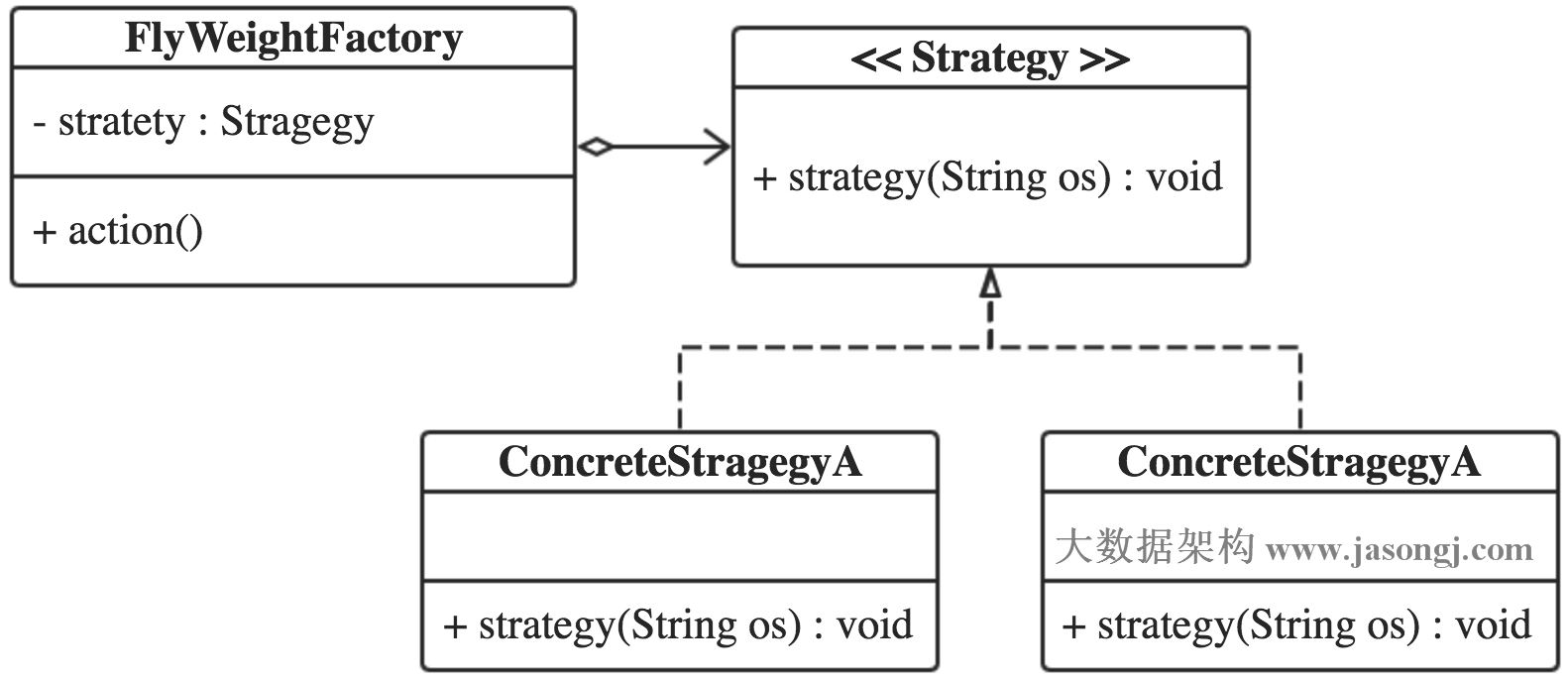Java设计模式(十二) 策略模式
策略模式(Strategy Pattern),将各种算法封装到具体的类中,作为一个抽象策略类的子类,使得它们可以互换。客户端可以自行决定使用哪种算法。
策略模式类图
策略模式类图如下

策略模式角色划分
- Strategy 策略接口或者(抽象策略类),定义策略执行接口
- ConcreteStrategy 具体策略类
- Context 上下文类,持有具体策略类的实例,并负责调用相关的算法
策略模式实例解析
本文代码可从 作者Github 下载
典型策略模式实现
策略接口,定义策略执行接口
package com.jasongj.strategy;
public interface Strategy {
void strategy(String input);
}
具体策略类,实现策略接口,提供具体算法
package com.jasongj.strategy;
import org.slf4j.Logger;
import org.slf4j.LoggerFactory;
@com.jasongj.annotation.Strategy(name="StrategyA")
public class ConcreteStrategyA implements Strategy {
private static final Logger LOG = LoggerFactory.getLogger(ConcreteStrategyB.class);
@Override
public void strategy(String input) {
LOG.info("Strategy A for input : {}", input);
}
}
package com.jasongj.strategy;
import org.slf4j.Logger;
import org.slf4j.LoggerFactory;
@com.jasongj.annotation.Strategy(name="StrategyB")
public class ConcreteStrategyB implements Strategy {
private static final Logger LOG = LoggerFactory.getLogger(ConcreteStrategyB.class);
@Override
public void strategy(String input) {
LOG.info("Strategy B for input : {}", input);
}
}
Context类,持有具体策略类的实例,负责调用具体算法
package com.jasongj.context;
import com.jasongj.strategy.Strategy;
public class SimpleContext {
private Strategy strategy;
public SimpleContext(Strategy strategy) {
this.strategy = strategy;
}
public void action(String input) {
strategy.strategy(input);
}
}
客户端可以实例化具体策略类,并传给Context类,通过Context统一调用具体算法
package com.jasongj.client;
import com.jasongj.context.SimpleContext;
import com.jasongj.strategy.ConcreteStrategyA;
import com.jasongj.strategy.Strategy;
public class SimpleClient {
public static void main(String[] args) {
Strategy strategy = new ConcreteStrategyA();
SimpleContext context = new SimpleContext(strategy);
context.action("Hellow, world");
}
}
使用Annotation和简单工厂模式增强策略模式
上面的实现中,客户端需要显示决定具体使用何种策略,并且一旦需要换用其它策略,需要修改客户端的代码。解决这个问题,一个比较好的方式是使用简单工厂,使得客户端都不需要知道策略类的实例化过程,甚至都不需要具体哪种策略被使用。
如《 Java设计模式(一) 简单工厂模式不简单 》所述,简单工厂的实现方式比较多,可以结合《 Java系列(一)Annotation(注解) 》中介绍的Annotation方法。
使用Annotation和简单工厂模式的Context类如下
package com.jasongj.context;
import java.util.Collections;
import java.util.Map;
import java.util.Set;
import java.util.concurrent.ConcurrentHashMap;
import org.apache.commons.configuration.ConfigurationException;
import org.apache.commons.configuration.XMLConfiguration;
import org.reflections.Reflections;
import org.slf4j.Logger;
import org.slf4j.LoggerFactory;
import com.jasongj.strategy.Strategy;
public class SimpleFactoryContext {
private static final Logger LOG = LoggerFactory.getLogger(SimpleFactoryContext.class);
private static Map<String, Class> allStrategies;
static {
Reflections reflections = new Reflections("com.jasongj.strategy");
Set<Class<?>> annotatedClasses =
reflections.getTypesAnnotatedWith(com.jasongj.annotation.Strategy.class);
allStrategies = new ConcurrentHashMap<String, Class>();
for (Class<?> classObject : annotatedClasses) {
com.jasongj.annotation.Strategy strategy = (com.jasongj.annotation.Strategy) classObject
.getAnnotation(com.jasongj.annotation.Strategy.class);
allStrategies.put(strategy.name(), classObject);
}
allStrategies = Collections.unmodifiableMap(allStrategies);
}
private Strategy strategy;
public SimpleFactoryContext() {
String name = null;
try {
XMLConfiguration config = new XMLConfiguration("strategy.xml");
name = config.getString("strategy.name");
LOG.info("strategy name is {}", name);
} catch (ConfigurationException ex) {
LOG.error("Parsing xml configuration file failed", ex);
}
if (allStrategies.containsKey(name)) {
LOG.info("Created strategy name is {}", name);
try {
strategy = (Strategy) allStrategies.get(name).newInstance();
} catch (InstantiationException | IllegalAccessException ex) {
LOG.error("Instantiate Strategy failed", ex);
}
} else {
LOG.error("Specified Strategy name {} does not exist", name);
}
}
public void action(String input) {
strategy.strategy(input);
}
}
从上面的实现可以看出,虽然并没有单独创建一个简单工厂类,但它已经融入了简单工厂模式的设计思想和实现方法。
客户端调用方式如下
package com.jasongj.client;
import com.jasongj.context.SimpleFactoryContext;
public class SimpleFactoryClient {
public static void main(String[] args) {
SimpleFactoryContext context = new SimpleFactoryContext();
context.action("Hellow, world");
}
}
从上面代码可以看出,引入简单工厂模式后,客户端不再需要直接实例化具体的策略类,也不需要判断应该使用何种策略,可以方便应对策略的切换。
策略模式分析
策略模式优点
- 策略模式提供了对“开闭原则”的完美支持,用户可以在不修改原有系统的基础上选择算法(策略),并且可以灵活地增加新的算法(策略)。
- 策略模式通过Context类提供了管理具体策略类(算法族)的办法。
- 结合简单工厂模式和Annotation,策略模式可以方便的在不修改客户端代码的前提下切换算法(策略)。
策略模式缺点
- 传统的策略模式实现方式中,客户端必须知道所有的具体策略类,并须自行显示决定使用哪一个策略类。但通过本文介绍的通过和Annotation和简单工厂模式结合,可以有效避免该问题
- 如果使用不当,策略模式可能创建很多具体策略类的实例,但可以通过使用上文《 Java设计模式(十一) 享元模式 》介绍的享元模式有效减少对象的数量。
正文到此结束
热门推荐
相关文章
Loading...











![[HBLOG]公众号](http://www.liuhaihua.cn/img/qrcode_gzh.jpg)

